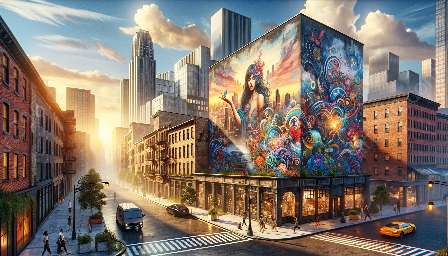Street art has always been a contentious and thought-provoking form of artistic expression, but perhaps its most radical departure from traditional art is its defiance of conventional notions of ownership and authorship in public spaces. In this discussion, we will delve into how street art challenges the established ideas of ownership and authorship, the implications for the public space, and the changing perceptions of street art in society.
The Evolution of Street Art
Historically, street art emerged as a form of rebellion, often executed surreptitiously under the cover of darkness. This clandestine nature was inherently tied to the art form's subversion of established authority, including the ownership of public space. By bypassing traditional art institutions and claiming public spaces as their canvases, street artists expanded the concept of authorship to include the entire community, challenging the idea that only designated individuals or institutions can produce and claim ownership of art.
The Public Space as a Canvas
Public spaces have long been synonymous with expressions of power and authority, often dominated by government-sanctioned monuments and advertisements. In contrast, street art disrupts this hierarchy by reclaiming public space as a platform for diverse voices and untold stories. Through the use of public walls, streets, and abandoned spaces, street artists assert their right to contribute to the visual and cultural landscape, challenging the conventional ownership of public space and inviting the community to engage with the art in new and meaningful ways.
Redefining Authorship
Another fundamental aspect of street art's challenge to conventional ownership and authorship is its subversion of the traditional artist as the sole author of a work. In the realm of street art, the creator often remains anonymous or uses pseudonyms, deliberately blurring the boundaries between individual authorship and collective ownership. This decentralization of authorship encourages a more egalitarian approach to art, emphasizing the shared ownership and interpretation of the work within the community.
Legal and Ethical Considerations
It is important to acknowledge that street art's rebellion against ownership and authorship is not without controversy. The unauthorized use of public spaces, defacement of property, and clashes with property owners and authorities raise complex ethical and legal questions. While some perceive street art as vandalism, others argue for its intrinsic value as a form of public dialogue and cultural expression, generating ongoing debates about the boundaries of ownership and authorship in public spaces.
Changing Perceptions and Cultural Impact
Over time, the perception of street art has shifted from an act of defiance to a celebrated form of artistic expression. As street art finds its way into galleries, museums, and urban revitalization projects, it fosters a reevaluation of conventional ownership and authorship in art. The public's evolving recognition and appreciation of street art as a legitimate cultural asset challenge traditional art world structures and redefine the boundaries of artistic ownership and authorship.
Conclusion
In conclusion, street art stands as a testament to the power of artistic expression to challenge and redefine conventional notions of ownership and authorship in public spaces. By subverting established authority, reclaiming public space, and reshaping the perception of art, street art ignites critical conversations about the dynamic relationship between art, public spaces, and the communities they inhabit.

